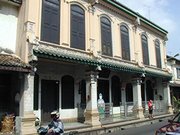Peranakan
|
|
Peranakan, Baba-Nyonya (峇峇娘惹) and Straits Chinese (after the Straits of Malacca) (土生華人) are terms used for the descendants of the early Chinese immigrants to the Nusantara region, including both the British Straits Settlements of Singapore, Malacca and Penang and the Dutch-controlled island of Java among other places.
The word Peranakan is also used to describe Indonesian Chinese. In both Malay and Bahasa Indonesia 'Peranakan' means 'descendants'. Babas refer to the male descendants and the Nyonyas the female.
Most Peranakan are of Hokkien ancestry, although a fair denomination of them are of the Teochew or Cantonese descent. Written records from the 19th and early 20th centuries show that Peranakan men usually took brides from within the local Peranakan community. Peranakan families also commonly imported brides from China and sent their daughters to China to find husbands. A small group of Indian Peranakans, known as the Chitty, does exist as well.
| Contents |
Language
Their language, Baba Malay [Bahasa Melayu Baba] , is a dialect of the Malay language [Bahasa Melayu], which contains many Hokkien words. It is a dying language and contemporary use is mainly limited to members of the older generation; this is indicative also of the Peranakan culture at large.
History
In the 15th century, the city states of the Malay Peninsula often paid tribute to various kingdoms such as the kingdoms of China and Siam. In return for such tribute, a princess of China was presented as a gift to the Sultan of Malacca at that time. The royalty and servants who accompanied the princess eventually grew into a class of straits-born Chinese known as the Peranakan. The Peranakan retained most of their ethnic and religious origins (ancestor worship), but assimilated the language and culture of the Malays. They developed a unique culture and distinct foods. A lot of sources claim that the early Peranakan inter-married with the local Malay population. However, the lack of physical resemblances have also led many experts to believe that the Peranakan Chinese ethnicity has hardly diluted. The Peranakan often sent their sons and daughters to China to look for spouses. Also, the religion of the local Malay population was Islam which forbids inter-marriage with other religions without conversion first. In the early 1800s, new Chinese immigrants to the Straits Settlements bolstered the Peranakan population.
By the middle of the Twentieth century, most Peranakan were English educated, as a result of the British colonisation of Malaya, and the natural propensity of these people who were able to easily embrace new cultures. Because the Peranakans readily embraced English culture and education, administrative and civil service posts were often filled by prominent Straits Chinese. The interaction with the British also caused many in the community to convert to Christianity. The Peranakan community thereby became very influential in Malacca and Singapore and were known also as the King's Chinese due to their perceived loyality to the British Crown. Because of the interaction of the different cultures and languages that Peranakans had, up to the mid-1900s, most Peranakans were trilingual, able to converse with Chinese, Malays and the British. Common vocations were as merchants, traders, and general intermediaries between China, Malaya and the West; the latter was especially valued by the British, since the Babas also enjoyed good relations with the Malay community and served as advisors to the royal Malay courts. In fact the term "Baba" is an honorific term in Malay; probably derived from Hindi/Sanskrit [Baba: literally means grandfather or father, and is used as a term of reverence and affection for an elderly gentleman].
Culture
Historical and cultural items from the Baba culture are displayed in cultural establishments on Heereen Street and Jonker Street in Malacca and in Penang in Malaysia, and at the Peranakan Museum in Singapore. There one can find museums displaying furnitures, foodwares, and even traditional clothes of the Baba and Nonya. There are also a small number of "Nyonya" restaurants in Singapore, Penang, Malacca, and the West.
The Peranakans were partially assimilated into the Malay culture (especially in food, dress, and language), while retaining some Chinese traditions (religion, name, and ethnic identitity), thereby creating a fusion culture of their own. For instance, from their Malay influence, a unique "Nyonya" cuisine has developed using the spices of Malay cuisine (examples are Chicken Kapitan, a dry chicken curry, and Inchi Kabin, a Nyonya version of fried chicken). The women (Nyonyas) have taken to wearing the baju kebaya (a Malay dress, seen most notably as the uniform of Malaysia and Singapore Airlines' female flight attendants). However, most of the Peranakans are not Muslim, and have retained the ancestral worship tradition of the Chinese; though some converted to Christianity. The wedding ceremony of the Peranakan is largely based on Chinese tradition, and is one of the most fascinating wedding ceremonies in Malaysia and Singapore.
The cause for their cultural extinction is largely due to racial politics and economics brought about by nationalism in Singapore and Malaysia. Without colonial British support for their perceived racial neutrality, Peranakans feel pressured to assimilate back into the mainstream Chinese culture in both countries following independence from the British. In Singapore, the Peranakans are classified as ethnically Chinese by government policies, and because second language instruction (so-called "Mother Tongue") is decided based on ethnicity, this requires them to learn Mandarin Chinese instead of Malay in formal education. While in Malaysia, the standardisation of Malay [Bahasa Melayu Malaysia] -required for all ethnic groups- has led to a disappearance of the unique characteristics of Baba Malay.
See Also
Books
- Lee Chin Koon: Mrs. Lee's Cookbook. Nonya Recipes a nd other favourite recipes.
- Mahmood, Datin Sari Endon, The Nyonya Kebaya: A Century of Straits Chinese Costume, ISBN 0794602738
External Links
- Penang State Museum (http://penang.insights.com.my/museum/html/baba.htm)
- The Peranakan Association of Singapore (http://www.peranakan.org.sg/)de:Baba-Nyonya

